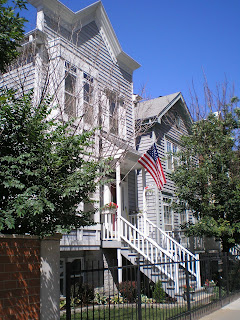 One of the most notorious gambling spots in pre-Fire Chicago was Hairtrigger Block, which ran along Randolph St., between Clark and State. A local newspaper wrote that this area had "become so contaminated by these execrable vagabonds that respectable persons avoid them as they would a cesspool."
One of the most notorious gambling spots in pre-Fire Chicago was Hairtrigger Block, which ran along Randolph St., between Clark and State. A local newspaper wrote that this area had "become so contaminated by these execrable vagabonds that respectable persons avoid them as they would a cesspool."One of Hairtrigger Block's best-known gamblers was Cap Hyman, who ran his own card house at 81 W. Randolph. Hyman's mistress was "Gentle" Annie Stafford, who had recently removed from The Sands, a lowlife resort which was located where the Tribune building now stands on N. Michigan Ave., but had recently been forced to open a new establishment at 155 N. Wells. On September 23, 1866, Gentle Annie, armed with a rawhide whip, stormed into Hyman's gambling den, dragged him out, knocked him downstairs, and chased him up Wells street. A few weeks later, Cap and Annie were legally married at a wedding attended by the cream of the underworld crop, not only from Chicago, but from St. Louis, Cincinnati, New Orleans, and Louisville.
Later, Hyman and Stafford opened a road house outside the city at what in what is now the Lakeview neighborhood, the opening of which was covered extensively in the newspapers. Hyman died after a mental breakdown in 1876, and Gentle Annie continued running a South-side brothel until 1880.
I suppose it's ironic that this show is now running in the exact location where Cap Hyman's gambing house once stood.



















